Spatial Dynamics of the Shore Coverage within the Zone of Influence of the Chambo River, Central Ecuador
Abstract
1. Introduction
2. Materials and Methods
2.1. Study Area
2.2. Pre-Processing of Satellite Images
2.3. Classification Analyses
- -
- Pasture (Level II): Vegetation characteristic of the slopes of the mountain ranges, belongs to the agricultural land group (Level I) of the coverage classification.
- -
- Crops (Level II): Coverage belonging to agricultural land. Annual, semi-permanent, and permanent crops can be identified in the Chambo River sub-basin, with corn and rice the predominant ones.
- -
- Forest: Coverage belonging to Level I of the coverage classification, which includes forest plantations and native forest (Level II). The forest cover present in this study area is composed of Polylepis forests (native), species of Eucalyptus globulus and Pinus radiata.
- -
- Anthropic Zone (Level I): Refers to the populated areas found in the sub-basin. Therefore, it refers to constructions and roads belonging to Level II of the aforementioned classification.
- -
- Soil and remnants of paramo: This refers to land with bare soil and remnants of vegetation belonging to paramo areas. They were not selected as separate covers because the existing density of paramo remnants is not significant.
2.4. Projection to 2030
3. Results
3.1. Classification Analysis
3.2. Change Trajectory Analysis
3.3. Cartographic Projection for the Year 2030
4. Discussion
5. Conclusions
- -
- Through a supervised classification using the maximum likelihood algorithm, the study area located within the upper middle basin of the Chambo River sub-basin corresponding to its source area was stratified, where five predominant land covers were identified, being pasture, crops, soil-remnants of paramo, forest, and anthropic.
- -
- The obtained maps allowed us to identify that in the first period (2000–2009), the soil cover-paramo remnants presented the highest percentage of loss and the crop cover the highest percentage of gain, and in the second period (2009–2019), the crop presented the highest percentages of gains and losses, transitions were attributed to population growth, afforestation, reforestation, deforestation and agricultural activities, volcanic eruptions, land colonization, and the expansion of agricultural activity.
- -
- The cartographic projection of the coverage in the riparian ecosystem for the year 2030 allowed us to determine that the anthropic zone and soil-remnants of the paramo will increase their area and the areas of pasture, cultivation, and forest will be reduced as these percentages were insignificant and those with the least impact compared to the periods corresponding to previous years.
Author Contributions
Funding
Conflicts of Interest
References
- Malanson, G.P. Riparian Landscapes; Cambridge Univ Press: Cambridge, UK, 1996. [Google Scholar]
- Sullivan, S.M.P.; Manning, D.W. Aquatic–terrestrial linkages as complex systems: Insights and advances from network models. Freshw. Sci. 2019, 38, 936–945. [Google Scholar] [CrossRef]
- Risser, P.G. The ecological importance of land-water ecotones. Ecol. Manag. Aquat. -Terr. Ecotones 1990, 4, 7–22. [Google Scholar]
- Krause, S.; Lewandowski, J.; Grimm, N.B.; Hannah, D.M.; Pinay, G.; McDonald, K.; Martí, E.; Argerich, A.; Pfister, L.; Klaus, J.; et al. Ecohydrological interfaces as hot spots of ecosystem processes. Water Resour. Res. 2017, 53, 6359–6376. [Google Scholar] [CrossRef]
- Naiman, R.J.; Decamps, H. The ecology of interfaces: Riparian zones. Annu. Rev. Ecol. Syst. 1997, 28, 621–658. [Google Scholar] [CrossRef]
- Stella, J.C.; Bendix, J. Multiple stressors in riparian ecosystems. In Multiple stressors in River Ecosystems; Elsevier: Amsterdam, The Netherlands, 2019; pp. 81–110. [Google Scholar]
- Gregory, S.V.; Swanson, F.J.; McKee, W.A.; Cummins, K.W. An ecosystem perspective of riparian zones. BioScience 1991, 41, 540–551. [Google Scholar] [CrossRef]
- Kutschker, A.; Brand, C.; Miserendino, M.L. Evaluación de La Calidad de Los Bosques de Ribera En Ríos Del NO Del Chubut Sometidos a Distintos Usos de La Tierra. Ecol. Austral 2009, 19, 19–34. Available online: https://www.researchgate.net/profile/Maria_Miserendino/publication/262141135_Evaluacion_de_la_calidad_de_los_bosques_de_ribera_en_rios_del_NO_del_Chubut_sometidos_a_distintos_usos_de_la_tierra/links/0deec536b8c3db01cf000000.pdf (accessed on 14 September 2020).
- Tonkin, J.D.; Merritt, D.; Olden, J.D.; Reynolds, L.V.; Lytle, D.A. Flow regime alteration degrades ecological networks in riparian ecosystems. Nat. Ecol. Evol. 2018, 2, 86–93. [Google Scholar] [CrossRef]
- Nilsson, C.; Berggren, K. Alterations of riparian ecosystems caused by river regulation: Dam operations have caused global-scale ecological changes in riparian ecosystems. How to protect river environments and human needs of rivers remains one of the most important questions of our time. BioScience 2000, 50, 783–792. [Google Scholar]
- Shafroth, P.B.; Stromberg, J.C.; Patten, D.T. Riparian vegetation response to altered disturbance and stress regimes. Ecol. Appl. 2002, 12, 107–123. [Google Scholar] [CrossRef]
- Talukdar, S.; Eibek, K.U.; Akhter, S.; Ziaul, S.K.; Islam, A.R.M.T.; Mallick, J. Modeling Fragmentation Probability of Land-Use and Land-Cover Using the Bagging, Random Forest and Random Subspace in the Teesta River Basin, Bangladesh. Ecol. Indic. 2021, 126, 107612. [Google Scholar] [CrossRef]
- Zhou, P.; Luukkanen, O.; Tokola, T.; Nieminen, J. Effect of vegetation cover on soil erosion in a mountainous watershed. Catena 2008, 75, 319–325. [Google Scholar] [CrossRef]
- Sánchez, V.D.R.S.; Tafur, J.R.A.; De la Vera, K.R.; Sánchez, M.S.A.; Alulema, A.C.L.; Ponce, L.R.A.; Morales, J.L.P.; Benavides, M.J.Z.; Pozo, M.D.R.; Campoverde, J.A.Y.; et al. Use of Geotechnologies and Multicriteria Evaluation in Land Use Policy-The Case of the Urban Area Expansion of the City of Babahoyo, Ecuador. In Proceedings of the 2019 Sixth International Conference on eDemocracy & eGovernment (ICEDEG), Quito, Ecuador, 24–26 April 2019; IEEE: Piscataway, NJ, USA, 2019; pp. 194–202. [Google Scholar]
- Barreto-Álvarez, D.E.; Heredia-Rengifo, M.G.; Padilla-Almeida, O.; Toulkeridis, T. Multitemporal evaluation of the recent land use change in Santa Cruz Island, Galapagos, Ecuador. In Information and Communication Technologies, Proceedings of the 8th Conference, TICEC 2020, Guayaquil, Ecuador, 25–27 November 2020; Springer: Cham, Switzerland, 2020; pp. 519–534. [Google Scholar]
- Heredia-R, M.; Cayambe, J.; Schorsch, C.; Toulkeridis, T.; Barreto, D.; Poma, P.; Villegas, G. Multitemporal Analysis as a Non-Invasive Technology Indicates a Rapid Change in Land Use in the Amazon: The Case of the ITT Oil Block. Environments 2021, 8, 139. [Google Scholar] [CrossRef]
- Pabón, J.D.; Rodríguez, N.; Bernal, N.R.; Castiblanco, M.A.; Sánchez, Y.V. Modelamiento Del Efecto Del Cambio En El Uso Del Suelo En El Clima Local-Regional Sobre Los Andes Colombianos. Rev. De Acad. Colomb. De Cienc. Exactas Físicas Y Nat. 2014, 37, 380–381. [Google Scholar] [CrossRef]
- Bronstert, A.; Niehoff, D.; Bürger, G. Effects of climate and land-use change on storm runoff generation: Present knowledge and modelling capabilities. Hydrol. Process. 2002, 16, 509–529. [Google Scholar] [CrossRef]
- Saad, R.; Koellner, T.; Margni, M. Land use impacts on freshwater regulation, erosion regulation, and water purification: A spatial approach for a global scale level. Int. J. Life Cycle Assess. 2013, 18, 1253–1264. [Google Scholar] [CrossRef]
- Alvarado, D. Dinámica Espacio-Temporal de La Cobertura de Bosque Seco Tropical Del Departamento Del Valle Del Cauca, Colombia. 2014, pp. 5–15. Available online: https://www.researchgate.net/publication/267626550_Dinamica_Espacio-Temporal_de_la_cobertura_de_Bosque_Seco_Tropical_del_Departamento_del_Valle_del_Cauca_Colombia (accessed on 13 September 2020).
- Toulkeridis, T.; Tamayo, E.; Simón-Baile, D.; Merizalde-Mora, M.J.; Reyes–Yunga, D.F.; Viera-Torres, M.; Heredia, M. Climate Change according to Ecuadorian academics–Perceptions versus facts. LA GRANJA. Rev. Cienc. Vida 2020, 31, 21–46. [Google Scholar] [CrossRef]
- Karamesouti, M.; Detsis, V.; Kounalaki, A.; Vasiliou, P.; Salvati, L.; Kosmas, C. Land-use and land degradation processes affecting soil resources: Evidence from a traditional Mediterranean cropland (Greece). Catena 2015, 132, 45–55. [Google Scholar] [CrossRef]
- Teketay, D. Deforestation, wood famine, and environmental degradation in Ethiopia’s highland ecosystems: Urgent need for action. Northeast. Afr. Stud. 2001, 8, 53–76. [Google Scholar] [CrossRef]
- Abid, M.; Schilling, J.; Scheffran, J.; Zulfiqar, F. Climate change vulnerability, adaptation and risk perceptions at farm level in Punjab, Pakistan. Sci. Total Environ. 2016, 547, 447–460. [Google Scholar] [CrossRef]
- Triplett, G.B., Jr.; Dick, W.A. No-tillage crop production: A revolution in agriculture! Agron. J. 2008, 100, S-153. [Google Scholar] [CrossRef]
- Scolozzi, R.; Geneletti, D. A Multi-Scale Qualitative Approach to Assess the Impact of Urbanization on Natural Habitats and Their Connectivity. Environ. Impact Assess. Rev. 2012, 36, 9–22. [Google Scholar] [CrossRef]
- Fischer, J.; Lindenmayer, D.B. Landscape modification and habitat fragmentation: A synthesis. Glob. Ecol. Biogeogr. 2007, 16, 265–280. [Google Scholar] [CrossRef]
- Pardini, R.; Nichols, E.; Püttker, T. Biodiversity response to habitat loss and fragmentation. Encycl. Anthr. 2017, 3, 229–239. [Google Scholar]
- Hobbs, R.J. Effects of landscape fragmentation on ecosystem processes in the Western Australian wheatbelt. Biol. Conserv. 1993, 64, 193–201. [Google Scholar] [CrossRef]
- Suarez, A.V.; Bolger, D.T.; Case, T.J. Effects of fragmentation and invasion on native ant communities in coastal southern California. Ecology 1998, 79, 2041–2056. [Google Scholar] [CrossRef]
- Farnum, F.; Vielka, M. Análisis Multitemporal (1970–2017) Del Uso Del Suelo en Cinco Comunidades Ubicadas a lo Largo de la Carretera Boydroosevelt, Panamá. 2019, pp. 108–110. Available online: https://www.researchgate.net/publication/334283429_ANALISIS_MULTITEMPORAL_1970-2017_DEL_USO_DEL_SUELO_EN_CINCO_COMUNIDADES_UBICADAS_A_LO_LARGO_DE_LA_CARRETERA_BOYDROOSEVELT_PANAMA (accessed on 13 September 2020).
- Chuvieco, E. Teledeteccion Ambiental—Emilio Chuvieco Salinero. 1995. Available online: https://books.google.es/books?id=aKsNXCVCtcQC&printsec=frontcover&dq=teledeteccion+ambiental&hl=es&sa=X&ved=0ahUKEwiE6vLagfbOAhULkRQKHQg2AhMQ6AEIGzAA#v=onepage&q=teledeteccionambiental&f=false (accessed on 13 September 2020).
- Massonne, H.J.; Toulkeridis, T. Widespread relics of high-pressure metamorphism confirm major terrane accretion in Ecuador: A new example from the Northern Andes. Int. Geol. Rev. 2012, 54, 67–80. [Google Scholar] [CrossRef]
- Toulkeridis, T.; Chunga, K.; Rentería, W.; Rodriguez, F.; Mato, F.; Nikolaou, S.; Cruz D’Howitt, M.; Besenzon, D.; Ruiz, H.; Parra, H.; et al. The 7.8 Mw Earthquake and Tsunami of the 16th April 2016 in Ecuador—Seismic evaluation, geological field survey and economic implications. Sci. Tsunami Hazards 2017, 36, 197–242. [Google Scholar]
- Chidichimo, F.; Mendoza, B.T.; De Biase, M.; Catelan, P.; Straface, S.; Di Gregorio, S. Hydrogeological modeling of the groundwater recharge feeding the Chambo aquifer, Ecuador. In AIP Conference Proceedings; AIP Publishing LLC: Melville, NY, USA, 2018; Volume 2022, p. 020003. [Google Scholar]
- PDOT-Chambo. ACTUALIZACIÓN DEL PLAN DE DESARROLLO Y ORDENAMIENTO TERRITORIAL DEL CANTÓN CHAMBO. 2019; pp. 52–2014. Available online: https://app.sni.gob.ec/sni-link/sni/PORTAL_SNI/data_sigad_plus/sigadplusdiagnostico/0660001680001_DIAGNOSTICO%20PDyOT%20CHAMBO%202014-2019_15-01-2015_16-16-38.pdf (accessed on 15 September 2020).
- Toulkeridis, T.; Zach, I. Wind directions of volcanic ash-charged clouds in Ecuador–implications for the public and flight safety. Geomat. Nat. Hazards Risk 2017, 8, 242–256. [Google Scholar] [CrossRef]
- Toulkeridis, T.; Arroyo, C.R.; Cruz D’Howitt, M.; Debut, A.; Vaca, A.V.; Cumbal, L.; Mato, F.; Aguilera, E. Evaluation of the initial stage of the reactivated Cotopaxi volcano–analysis of the first ejected fine-grained material. Nat. Hazards Earth Syst. Sci. Discuss. 2015, 3, 6947–6976. [Google Scholar]
- Toulkeridis, T.; Seqqat, R.; Arias, M.T.; Salazar-Martinez, R.; Ortiz-Prado, E.; Chunga, S.; Vizuete, K.; Heredia-R, M.; Debut, A. Volcanic Ash as a precursor for SARS-CoV-2 infection among susceptible populations in Ecuador: A satellite Imaging and excess mortality-based analysis. In Disaster Medicine and Public Health Preparedness; Cambridge University Press: Cambridge, UK, 2021; pp. 1–13. [Google Scholar]
- MAGAP; MAE. Mapa de Cobertura y Uso de La Tierra Del Ecuador Continental 2013–2014. 2015. Available online: https://app.sni.gob.ec/sni-link/sni/Portal%20SNI%202014/USO%20DE%20LA%20TIERRA/05-MAPA_NACIONAL_COBERTURA_USO.pdf (accessed on 20 September 2020).
- MAE (Ministerio del Ambiente Ecuador). Evaluación de Necesidades Tecnológicas Para El Manejo de La Oferta Hídrica En Cantidad y Calidad. 2013. Available online: https://tech-action.unepdtu.org/wp-content/uploads/sites/2/2013/12/evaluacionnecesidadestecnologicas-adaptacion-ofertahidrica-ecuador-12.pdf (accessed on 20 September 2020).
- Ochoa-Tocachi, B.F.; Buytaert, W.; De Bievre, B.; Célleri, R.; Crespo, P.; Villacís, M.; Llerena, C.A.; Acosta, L.; Villazón, M.; Guallpa, M.; et al. Impacts of Land Use on the Hydrological Response of Tropical Andean Catchments. Hydrol. Process. 2016, 30, 4074–4089. [Google Scholar] [CrossRef]
- Suárez, G.; Olaya, L. Aplicación de Un Modelo Predictivo Para El Análisis Del Impacto Generado Por El Cambio de Cobertura Urbana En El Municipio de Mosquera, Cundinamarca; Universidad Distrital Francisco José de Caldas: Bogotá, Colombia, 2018. [Google Scholar]
- Clerici, N.; Paracchini, M.L.; Maes, J. Land-Cover Change Dynamics and Insights into Ecosystem Services in European Stream Riparian Zones. Ecohydrol. Hydrobiol. 2014, 14, 107–120. [Google Scholar] [CrossRef]
- Pazmiño, Y.; de Felipe, J.J.; Vallbé, M.; Cargua, F.; Quevedo, L. Identification of a Set of Variables for the Classification of Páramo Soils Using a Nonparametric Model, Remote Sensing, and Organic Carbon. Sustainability 2021, 13, 9462. [Google Scholar] [CrossRef]
- Fiorini, E.; Tibaldi, A. Quaternary tectonics in the central Interandean Valley, Ecuador: Fault-propagation folds, transfer faults and the Cotopaxi Volcano. Glob. Planet. Chang. 2012, 90, 87–103. [Google Scholar] [CrossRef]
- Winkler, W.; Villagómez, D.; Spikings, R.; Abegglen, P.; Egüez, A. The Chota basin and its significance for the inception and tectonic setting of the inter-Andean depression in Ecuador. J. South Am. Earth Sci. 2005, 19, 5–19. [Google Scholar] [CrossRef]
- Jumbo, F. Delimitación Automática de Microcuencas Utilizando Datos SRTM de La NASA (Automatic Delimitation of Microwatershed Using SRTM Data of the NASA). Enfoque UTE 2015, 6, 81–97. Available online: https://ingenieria.ute.edu.ec/enfoqueute/ (accessed on 20 September 2020). [CrossRef][Green Version]
- Zhica, J. Caracterización Morfométrica y Estudio Hidrológico de La Microcuenca Del Río San Francisco, Cantón; Universidad Politécnica Salesiana: Cuenca, Ecuador, 2020. [Google Scholar]
- Vega, X. Diferentes Soluciones Para La Delimitación y Codificación de Cuencas Superficiales Cubanas. Ing. Hidráulica Ambient. 2020, 41, 75–84. [Google Scholar]
- Aguilar, S. Fórmulas Para El Cálculo de La Muestra En Investigaciones de Salud. Salud Tabasco 2005, 11, 333–338. Available online: https://www.redalyc.org/articulo.oa?id=48711206 (accessed on 20 September 2020).
- Arias, H.A.; Zamora, R.M.; Bolaños, C.V. Metodología Para La Corrección Atmosférica de Imágenes ASTER, RAPIDEYE, SPOT 2 Y LANDSAT 8 Con El Módulo FLAASH Del Software ENVI. Rev. Geográfica América Cent. 2014, 2, 39–59. Available online: https://www.redalyc.org/pdf/4517/451744544002.pdf (accessed on 25 September 2020).
- Chander, G.; Markham, B. Revised Landsat-5 TM Radiometrie Calibration Procedures and Postcalibration Dynamic Ranges. IEEE Trans. Geosci. Remote Sens. 2003, 41, 2674–2677. [Google Scholar] [CrossRef]
- Wilson, C.O.; Weng, Q. Simulating the Impacts of Future Land Use and Climate Changes on Surface Water Quality in the Des Plaines River Watershed, Chicago Metropolitan Statistical Area, Illinois. Sci. Total Environ. 2011, 409, 4387–4405. [Google Scholar] [CrossRef]
- Fernández, I.; Herrero, E. El Satélite Landsat. Análisis Visual de Imágenes Obtenidas Del Sensor ETM+ Satélite Landsat. 2001. Available online: https://www.cartesia.org/data/apuntes/teledeteccion/landsat-analisis-visual.pdf (accessed on 25 September 2020).
- Paegelow, M.; Camacho Olmedo, M.T. Modelos de Simulacion Espacio-Temporal y Teledeteccion: El Método de La Segmentacion Para La Cartografia Cronologica de Usos Del Suelo. 2010. Available online: https://halshs.archives-ouvertes.fr/halshs-01063980 (accessed on 30 September 2020).
- Brenes, C. Tutorial de Clasificación Supervisada de Imágenes de Satétite Con QGIS y R Statistics; Managua, Nicaragua, 2019. [Google Scholar] [CrossRef]
- Maselli, F.; Conese, C.; De Filippis, T.; Romani, M. Integration of Ancillary Data into a Maximum-Likelihood Classifier with Nonparametric Priors. ISPRS J. Photogramm. Remote Sens. 1995, 50, 2–11. [Google Scholar] [CrossRef]
- García Mora, T.J.; Mas, J.F. Comparación de Metodologías Para El Mapeo de La Cobertura y Uso Del Suelo En El Sureste de México Comparison of Methodologies for Mapping Land Use Cover in Southeast Mexico. Investig. Geográficas 2008, 67, 7–19. [Google Scholar]
- Gismondi, M.; Kamusoko, C.; Furuya, T.; Tomimura, S.; Maya, M. MOLUSCE An Open Source Land Use Change Analyst for QGIS. 2014. Available online: https://www.ajiko.co.jp/download/pdf_tf2014/p62-63.pdf (accessed on 30 September 2020).
- Palacios, J. Evaluación de La Dinámica Del Cambio de La Cobertura y Uso de Tierra En El Área de Influencia de La Propuesta de Carretera Bellavista, Mazan, Salvador, El Estrecho. 2019. Available online: https://terra.iiap.gob.pe/assets/files/riesgos/2018/01_2018_EVALUACION_DINAMICA_CAMBIO_DE_COBERTURA_ESTRECHO.pdf (accessed on 30 September 2020).
- Bautista, K. Estudio Del Aprovechamiento Hídrico de La Microcuenca Del Río Alao Desde Los Usos de Concesión. Esc. Super. Politécnica Chimborazo 2009, 2, 3500. [Google Scholar]
- Bautista Rojas, V.I. Estudio de La Calidad Del Agua de La Cuencas Del Rio Chambo En Época de Estiaje. Escuela Superior Politécnica de Chimborazo, vol. Bachelor. 2014. Available online: https://dspace.espoch.edu.ec/handle/123456789/3221 (accessed on 30 September 2020).
- Echeverría, J. Dinámica Espacial de La Cobertura de Ribera de La Zona de Influencia Del Río Chambo; Escuela Superior Politécnica de Chimborazo: Riobamba, Ecuador, 2021; Available online: http://dspace.espoch.edu.ec/handle/123456789/15313#:~:text=La%20proyecci%C3%B3n%20cartogr%C3%A1fica%20de%20la,disminuir%C3%A1n%20en%200.45%25%20y%200.43%25 (accessed on 30 September 2020).
- Anupam, A. Accuracy Assesment. Ignou: The people´s University. 2017. Available online: https://www.researchgate.net/publication/324943246_UNIT_14_ACCURACY_ASSESSMENT (accessed on 30 September 2020).
- Ayala-Izurieta, J.E.; Márquez, C.O.; García, V.J.; Recalde-Moreno, C.G.; Rodríguez-Llerena, M.V.; Damián-Carrión, D.A. Land Cover Classification in an Ecuadorian Mountain Geosystem Using a Random Forest Classifier, Spectral Vegetation Indices, and Ancillary Geographic Data. Geosciences 2017, 7, 34. [Google Scholar] [CrossRef]
- Plata, W. Descripción, Análisis y Simulación Del Crecimiento Urbano Mediante Tecnologías de La Información Geográfica. El Caso de La Comunidad de Madrid. Universidad de Alcalá. 2010. Available online: https://dialnet.unirioja.es/servlet/tesis?codigo=89948&info=resumen&idioma=ENG (accessed on 30 September 2020).
- Pontius, R.G., Jr.; Shusas, E.; McEachern, M. Detecting Important Categorical Land Changes While Accounting for Persistence. Agric. Ecosyst. Environ. 2004, 101, 251–268. [Google Scholar] [CrossRef]
- Braimoh, A. Random and Systematic Land-Cover Transitions in Northern Ghana. Agric. Ecosyst. Environ. 2006, 113, 254–263. [Google Scholar] [CrossRef]
- Vargas, O.; Patricia, V. Páramos Andinos Reviviendo Nuestros Páram Os Restauración Ecológica de Páramos. Proyecto Páramo Andino. 2011. Available online: https://biblio.flacsoandes.edu.ec/libros/digital/56494.pdf (accessed on 30 September 2020).
- MAE; MAGAP. Protocolo Metodológico Para La Elaboración Del Mapa de Cobertura y Uso de La Tierra Del Ecuador Continental 2013–2014, Escala 1:100.000. May 2013. Available online: www.magap.gob.ec (accessed on 30 September 2020).
- Li, Y.; Zhu, X.; Pan, Y.; Gu, J.; Zhao, A.; Liu, X. A Comparison of Model-Assisted Estimators to Infer Land Cover/Use Class Area Using Satellite Imagery. Remote Sens. 2014, 6, 8904–8922. [Google Scholar] [CrossRef]
- Landis, J.R.; Koch, G.G. The Measurement of Observer Agreement for Categorical Data. Biometrics 1977, 33, 159. [Google Scholar] [CrossRef]
- Muhammad, R.; Zhang, W.; Abbas, Z.; Guo, F.; Gwiazdzinski, L. Spatiotemporal Change Analysis and Prediction of Future Land Use and Land Cover Changes Using QGIS MOLUSCE Plugin and Remote Sensing Big Data: A Case Study of Linyi, China. Land 2022, 11, 419. [Google Scholar] [CrossRef]
- Bustamante, M.; Alban, M.; Arguello, M. Los Páramos de Chimborazo. Un Estudio Socioambiental Para La Toma de Decisiones. EcoCiencia & CONDENSAN. 2011. Available online: https://biblio.flacsoandes.edu.ec/libros/digital/56619.pdf (accessed on 1 November 2020).
- Pierre, H. 30 Años de Reforma Agraria y Colonización En El Ecuador: 1964-1994; Dinámicas Espaciales: Quito, Ecuador, 2001. [Google Scholar]
- FIEDS. Proyecto Forestación y Reforestación de La Subcuenca Del Río Chambo|Fieds.Org. 2017. Available online: https://fieds.org/historia-fie/convocatoria/proyecto-forestacion-y-reforestacion-de-la-subcuenca-del-rio-chambo/ (accessed on 1 November 2020).
- Arias, H.; Miguel, P. Estudio Hidráulico Del Río Chambo Para La Determinación de La Conductancia Entre Río-Acuífero y Zonas de Inundación. Universidad Nacional de Chimborazo, 2018. 2018. Available online: https://dspace.unach.edu.ec/handle/51000/4876 (accessed on 3 November 2020).
- Enderle, D.I.; Weih, R.C., Jr. Integrating Supervised and Unsupervised Classification Methods to Develop a More Accurate Land Cover Classification. J. Ark. Acad. Sci. 2005, 59, 65–73. Available online: https://scholarworks.uark.edu/jaas/vol59/iss1/10 (accessed on 3 November 2020).
- Mohammady, M.; Moradi, H.R.; Zeinivand, H.; Temme, A.J.A.M. A Comparison of Supervised, Unsupervised and Synthetic Land Use Classification Methods in the North of Iran. Int. J. Environ. Sci. Technol. 2014, 12, 1515–1526. [Google Scholar] [CrossRef]
- Nijhawan, R.; Srivastava, I.; Shukla, P. Land Cover Classification Using Super-Vised and Unsupervised Learning Techniques. In Proceedings of the ICCIDS 2017—International Conference on Computational Intelligence in Data Science, Chennai, India, 2–3 June 2017; Institute of Electrical and Electronics Engineers Inc.: Piscataway, NJ, USA, 2018; pp. 1–6. [Google Scholar] [CrossRef]
- Curatola Fernández, G.F.; Obermeier, W.A.; Gerique, A.; López Sandoval, M.F.; Lehnert, L.W.; Thies, B.; Bendix, J. Land Cover Change in the Andes of Southern Ecuador—Patterns and Drivers. Remote Sens. 2015, 7, 2509–2542. [Google Scholar] [CrossRef]
- Viña, A.; Echavarria, F.R.; Rundquist, D.C. Satellite Change Detection Analysis of Deforestation Rates and Patterns along the Colombia—Ecuador Border. AMBIO A J. Hum. Environ. 2004, 33, 118–125. [Google Scholar] [CrossRef] [PubMed]
- Ross, C.; Fildes, S.; Millington, A.C. Land-Use and Land-Cover Change in the Páramo of South-Central Ecuador, 1979–2014. Land 2017, 6, 46. [Google Scholar] [CrossRef]
- Cogle, L.C.; Cualchi, D.V.T.; Morocho, C.M.P.; Torres, D.X.T.; de Aparicio, C.X.P. La Migración de Zonas Rurales a Zonas Urbanas En El Ecuador. RECIMUNDO 2021, 5, 14–21. [Google Scholar] [CrossRef]
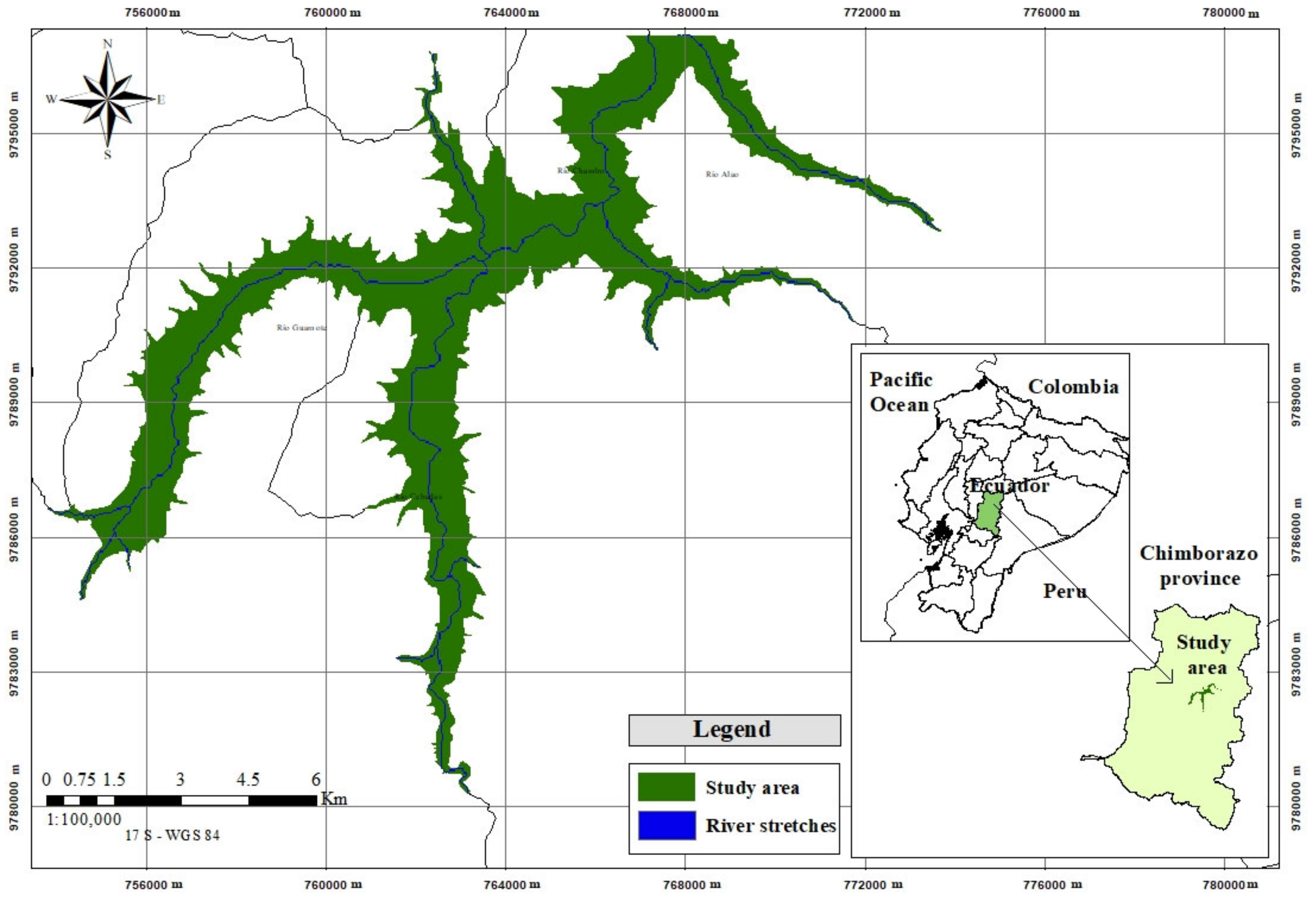
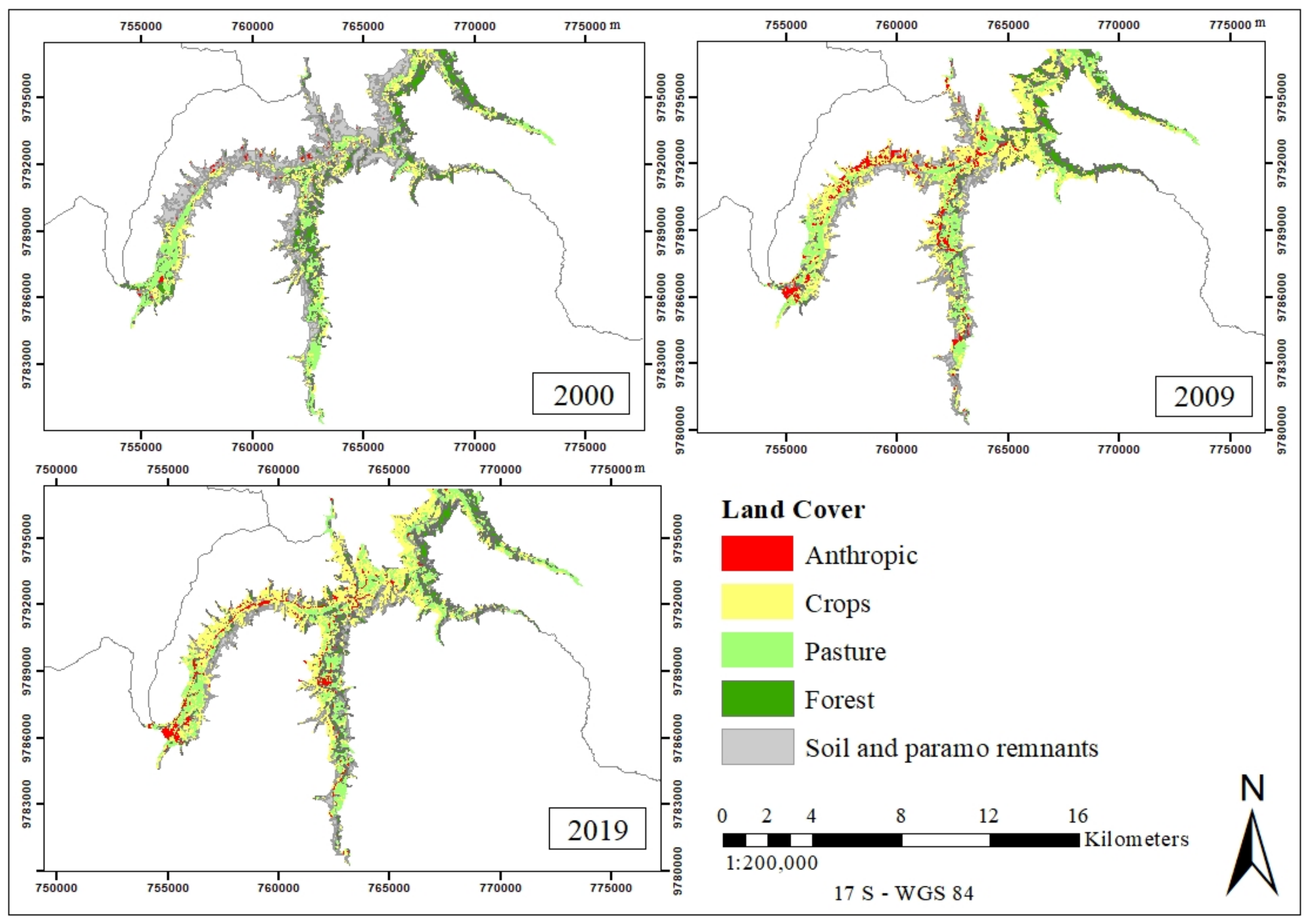
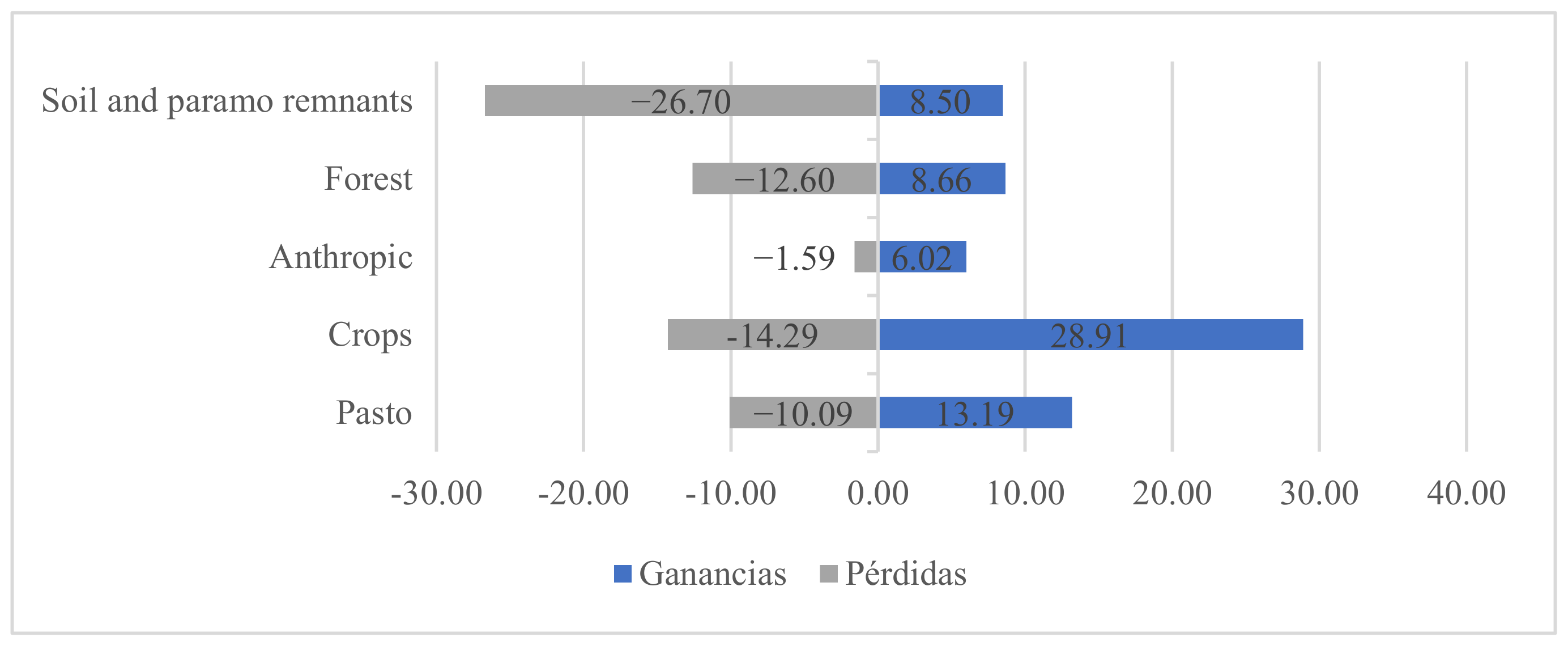
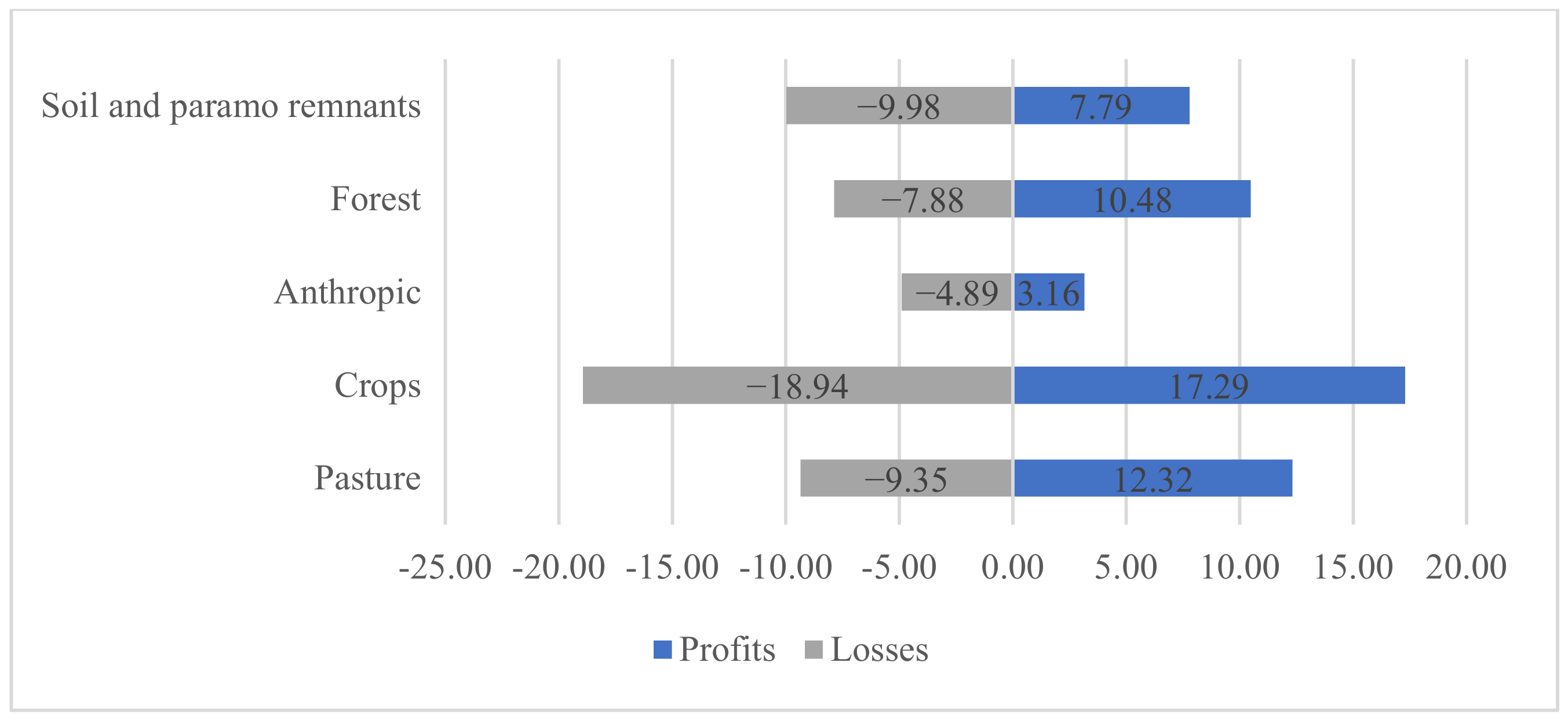
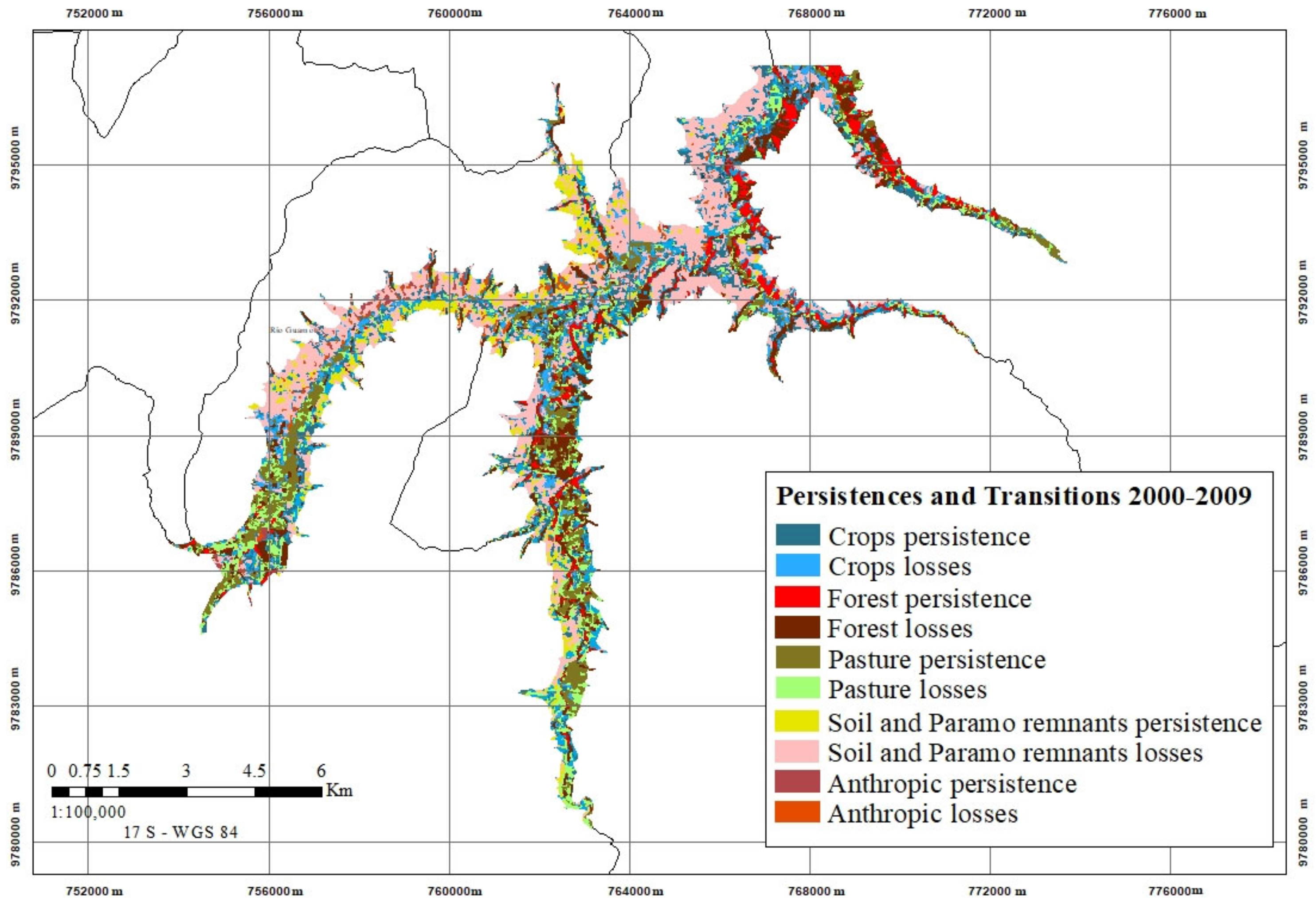
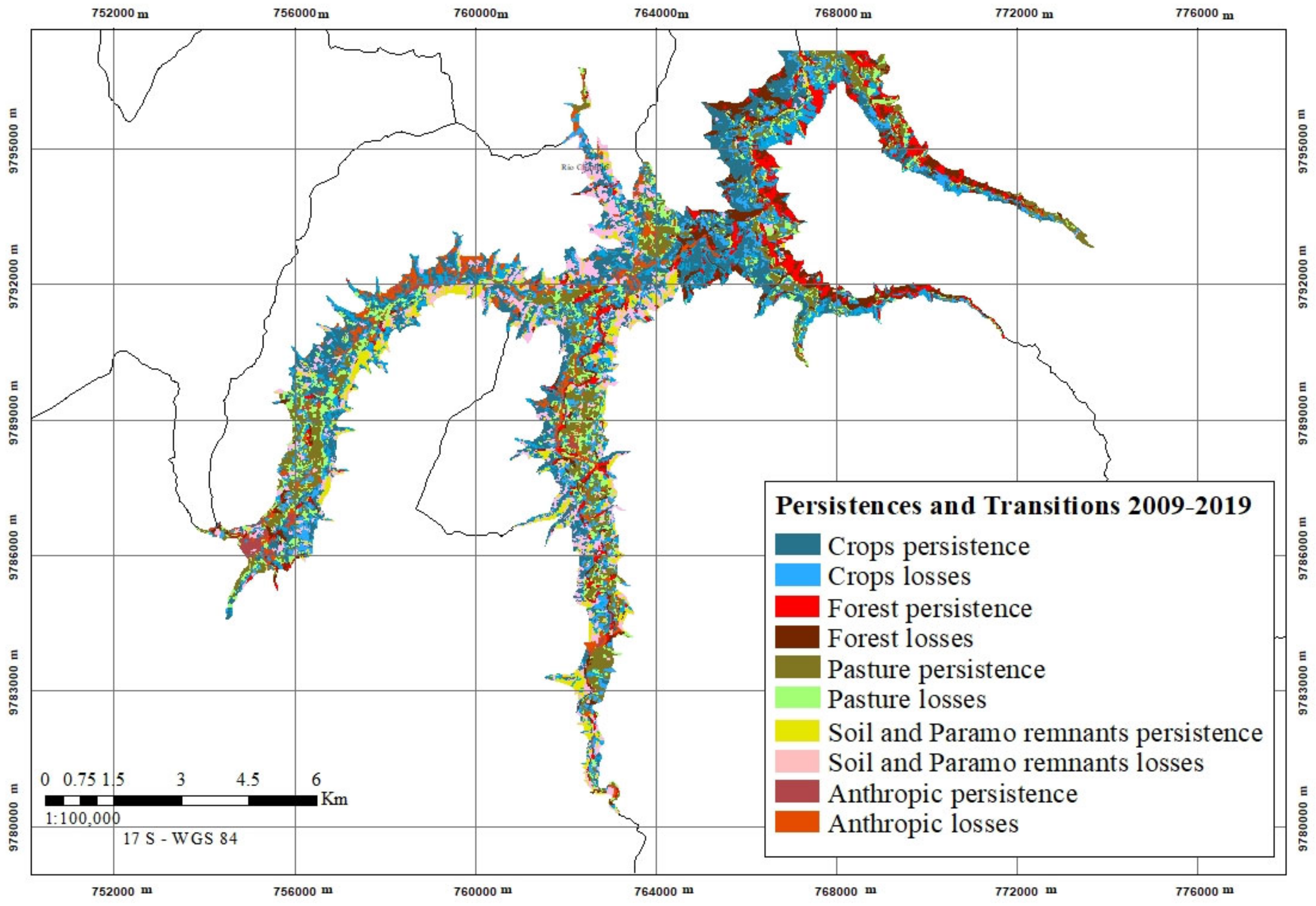
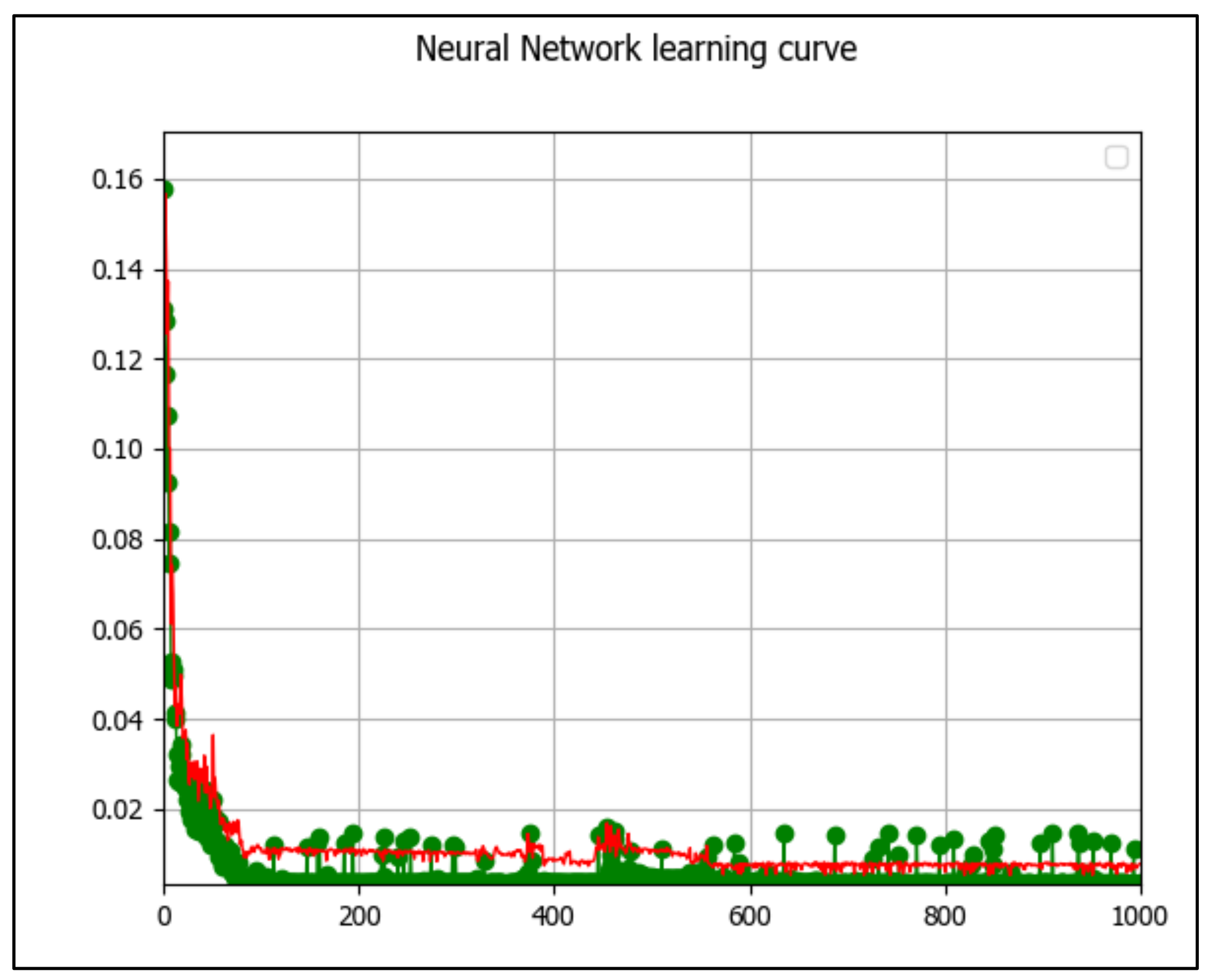
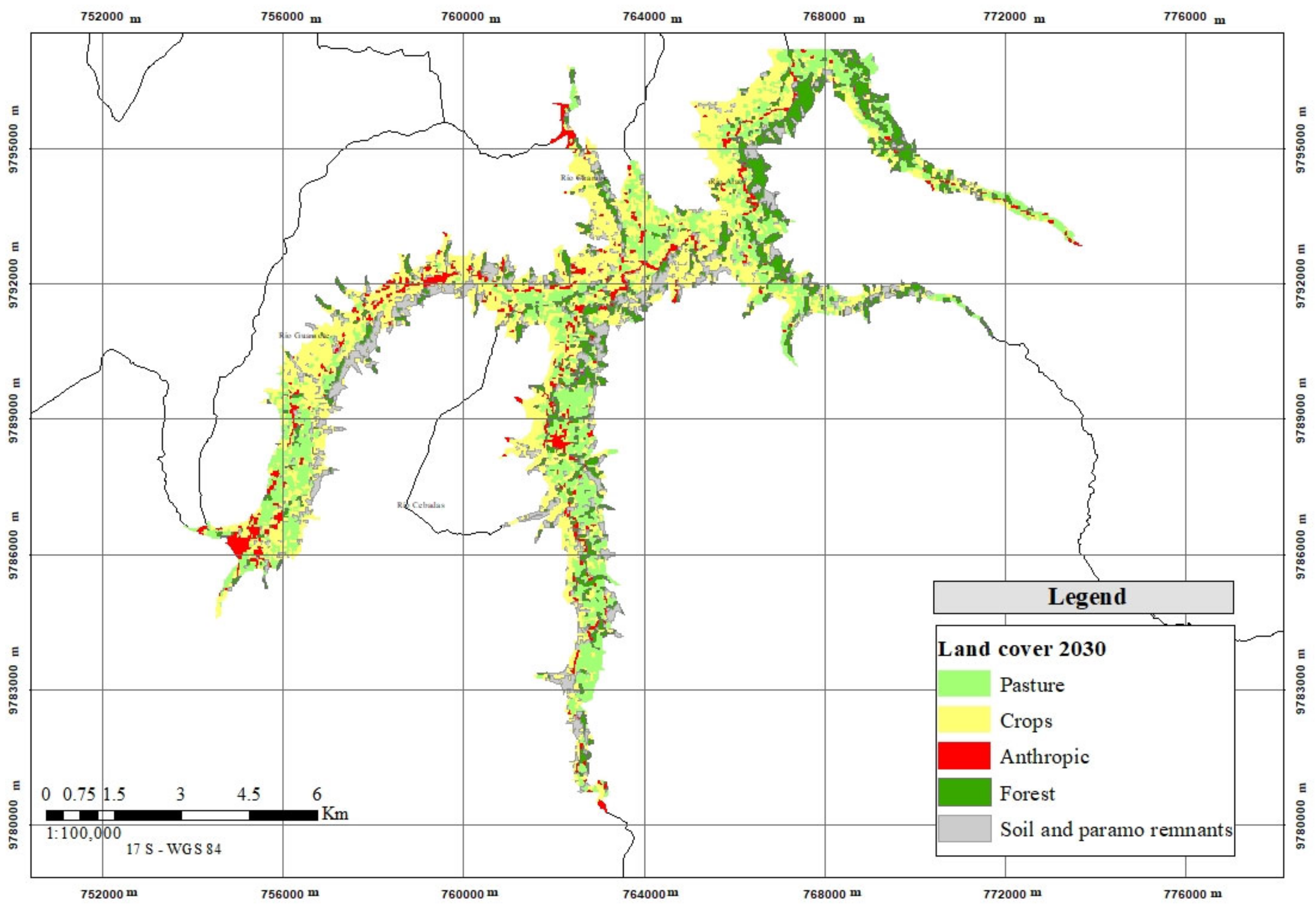

| Cross Tabulation Matrix | |||||||
| Year 2 | |||||||
| Year 1 | Pasture (1) | Crops (2) | Forest (3) | Anthropic Zone (4) | Soil and Remnants of Paramo (5) | Total Year 1 | Losses |
| Pasture (1) | A11 | A12 | A13 | A14 | A15 | ΣA | ΣA−A55 |
| Crops (2) | A21 | A22 | A23 | A14 | A15 | ΣA | ΣA−A11 |
| Forest (3) | A31 | A32 | A33 | A34 | A35 | ΣA | ΣA−A33 |
| Anthropic Zone (4) | A41 | A42 | A43 | A44 | A45 | ΣA | ΣA−A44 |
| Soil and remnants of paramo (5) | A51 | A52 | A53 | A54 | A55 | ΣA | ΣA−A55 |
| Total year 2 | ΣA | ΣA | ΣA | ΣA | ΣA | ||
| Gains | ΣA−A11 | ΣA−A22 | ΣA−A33 | ΣA−A44 | ΣA−A55 | ||
| Measure | Equation | ||||||
| Parameters for the analysis of land cover changes | Where Axy is the area of change between classes Net change = |Gains − Losses| Total change = Gains + Losses Exchange = 2 * MIN (Losses over time 2 − No coverage changes, Gains over time 2 − No coverage changes) Where: | ||||||
| Vulnerability | gp = gain/persistence lp = loss/persistence | ||||||
| Braimoh Persistence Indices | np= gp − lp Where: gp = gain persistence; lp = loss persistence; np = net persistence change | ||||||
| Pasture | Crop | Anthropic Zone | Forest | Soil and Remnants of Paramo | |
| 2000 | |||||
| % User Accuracy | 87.50 | 29.03 | 94.12 | 80.30 | 79.17 |
| % Producer Accuracy | 64.62 | 50.00 | 100.00 | 86.89 | 76.00 |
| 2009 | |||||
| % User Accuracy | 93.55 | 73.53 | 95.65 | 92.11 | 53.33 |
| % Producer Accuracy | 90.63 | 71.43 | 80.00 | 89.74 | 94.12 |
| 2019 | |||||
| % User Accuracy | 96.96969697 | 86.21 | 98.11 | 100.00 | 65.22 |
| % Producer Accuracy | 100 | 71.43 | 94.55 | 100.00 | 88.24 |
| Year | Precision Measurements | Kappa Index | ||
|---|---|---|---|---|
| Producer Accuracy | User Accuracy | Overall Accuracy | ||
| 2000 | 75.50% | 74.02% | 75.24% | 0.68 |
| 2009 | 85.18% | 81.63% | 84.76% | 0.80 |
| 2019 | 90.84% | 89.30% | 92.86% | 0.91 |
| 2009 | |||||||||
| Pasture | Crop | Anthropic | Forest | Soil and Remnants of Paramo | |||||
| Coding | 10 | 20 | 30 | 40 | 50 | Total 2010 | Gain | ||
| 2000 | Pasture | 1 | 9.79 | 5.14 | 1.16 | 2.26 | 1.54 | 19.88 | 10.09 |
| Crop | 2 | 4.89 | 11.11 | 1.56 | 3.22 | 4.62 | 25.40 | 14.29 | |
| Anthropic | 3 | 0.14 | 1.01 | 0.90 | 0.07 | 0.36 | 2.49 | 1.59 | |
| Forest | 4 | 4.52 | 5.36 | 0.73 | 6.15 | 1.99 | 18.75 | 12.60 | |
| Soil and remnants of paramo | 5 | 3.63 | 17.39 | 2.57 | 3.11 | 6.77 | 33.48 | 26.70 | |
| Total 2017 | 22.98 | 40.02 | 6.92 | 14.81 | 15.27 | ||||
| Gain | 13.19 | 28.91 | 6.02 | 8.66 | 8.50 | 65.27 | |||
| 2019 | |||||||||
| Pasture | Crop | Anthropic | Forest | Soil & Remnants of Paramo | |||||
| Coding | 10 | 20 | 30 | 40 | 50 | Total 2010 | Gain | ||
| 2009 | Pasture | 1 | 13.63 | 4.60 | 1.00 | 2.83 | 0.92 | 22.98 | 9.35 |
| Crop | 2 | 8.06 | 21.08 | 1.45 | 4.94 | 4.49 | 40.02 | 18.94 | |
| Anthropic | 3 | 1.02 | 3.05 | 2.03 | 0.43 | 0.40 | 6.92 | 4.89 | |
| Forest | 4 | 1.97 | 3.57 | 0.35 | 6.93 | 1.98 | 14.81 | 7.88 | |
| Soil and remnants of paramo | 5 | 1.27 | 6.07 | 0.36 | 2.28 | 5.29 | 15.27 | 9.98 | |
| Total 2017 | 25.95 | 38.37 | 5.19 | 17.41 | 13.08 | ||||
| Gain | 12.32 | 17.29 | 3.16 | 10.48 | 7.79 | 51.04 | |||
| Net Change | Exchange | Total Change | |
| Pasture | 3.10 | 20.18 | 23.28 |
| Crop | 14.62 | 28.58 | 43.20 |
| Anthropic | 4.43 | 3.17 | 7.61 |
| Forest | 3.94 | 17.32 | 21.26 |
| Soil and remnants of paramo | 18.20 | 17.00 | 35.21 |
| Summation | 44.28 | 86.26 | 130.54 |
| Total | 22.14 | 43.13 | 65.27 |
| Net Change | Exchange | Total Change | |
| Pasture | 2.97 | 18.70 | 21.67 |
| Crop | 1.65 | 34.58 | 36.23 |
| Anthropic | 1.73 | 6.32 | 8.05 |
| Forest | 2.60 | 15.76 | 18.36 |
| Soil and remnants of paramo | 2.19 | 15.58 | 17.77 |
| Summation | 11.15 | 90.94 | 102.09 |
| Total | 5.58 | 45.47 | 51.04 |
| Code | Change | Area (ha) | Code | Change | Area (ha) |
| 11 | Pasture remained | 457.19 | 33 | Anthropic remained | 42.24 |
| 12 | From crop to pasture | 228.23 | 34 | From forest to anthropic | 33.9 |
| 13 | From anthropic to pasture | 6.51 | 35 | From soil and remnants of paramo to anthropic | 119.92 |
| 14 | From forest to pasture | 211.27 | 41 | From pasture to forest | 105.32 |
| 15 | From soil and remnants of paramo to pasture | 169.71 | 42 | From cultivation to forest | 150.58 |
| 21 | From pasture to crop | 239.93 | 43 | From anthropic to forest | 3.33 |
| 22 | Cultivation was maintained | 518.76 | 44 | Forest remained | 287.18 |
| 23 | From anthropic to cultivation | 47.22 | 45 | From soil and remnants of paramo to forest | 145.08 |
| 24 | From forest to farm | 250.39 | 51 | From pasture to soil and remnants of paramo | 71.69 |
| 25 | From soil and paramo remnants to Cultivation | 812.23 | 52 | From cultivation to soil and remnants of paramo | 215.56 |
| 31 | From pasture to anthropic | 54.26 | 53 | From anthropic to soil and remnants of paramo | 17.03 |
| 32 | From cultivation to anthropology | 72.95 | 54 | From forest to soil and remnants of paramo | 92.71 |
| 55 | Soil and remnants of paramo remained | 316.24 |
| Code | Change | Area (ha) | Code | Change | Area (ha) |
| 11 | Pasture remained | 636.34 | 33 | Anthropic remained | 94.76 |
| 12 | From crop to pasture | 376.49 | 34 | From forest to anthropic | 16.43 |
| 13 | From anthropic to pasture | 47.52 | 35 | From soil and remnants of paramo to anthropic | 16.77 |
| 14 | From forest to pasture | 92.07 | 41 | From pasture to forest | 132.37 |
| 15 | From soil and remnants of paramo to pasture | 59.28 | 42 | From cultivation to forest | 230.44 |
| 21 | From pasture to crop | 214.65 | 43 | From anthropic to forest | 20.03 |
| 22 | Cultivation was maintained | 984.18 | 44 | Forest remained | 323.56 |
| 23 | From anthropic to cultivation | 142.38 | 45 | From soil and remnants of paramo to forest | 106.65 |
| 24 | From forest to farm | 166.85 | 51 | From pasture to soil and remnants of paramo | 42.82 |
| 25 | From soil and paramo remnants to cultivation | 283.38 | 52 | From cultivation to soil and remnants of paramo | 209.81 |
| 31 | From pasture to anthropic | 46.73 | 53 | From anthropic to soil and remnants of paramo | 18.59 |
| 32 | From cultivation to anthropology | 67.61 | 54 | From forest to soil and remnants of paramo | 92.57 |
| 55 | Soil and remnants of paramo remained | 247.15 |
| 2000–2009 | 2009–2019 | |||||
| gp | lp | np | gp | lp | np | |
| Pasture | 1.35 | 1.03 | 0.32 | 0.90 | 0.69 | 0.22 |
| Crop | 2.60 | 1.29 | 1.32 | 0.82 | 0.90 | −0.08 |
| Anthropic | 6.65 | 1.75 | 4.90 | 1.56 | 2.41 | −0.85 |
| Forest | 1.41 | 2.05 | −0.64 | 1.51 | 1.14 | 0.38 |
| Soil and remnants of paramo | 1.26 | 3.94 | −2.69 | 1.47 | 1.89 | −0.41 |
| Year | 2000 | 2009 | Exchange rate 2000–2009 | 2019 | Exchange rate 2009–2019 | 2030 | Exchange rate 2019–2030 | |||||||
| Coverage | Area (ha) | % | Area (ha) | % | Area (ha) | % | Area (ha) | % | Area (ha) | % | Area (ha) | % | Area (ha) | % |
| Pasture | 928.39 | 19.88 | 1072.91 | 22.98 | 144.52 | 3.10 | 1211.71 | 25.95 | 138.80 | 2.97 | 1191.72 | 25.52 | −19.99 | −0.43 |
| Crop | 1186.07 | 25.40 | 1868.52 | 40.02 | 682.45 | 14.62 | 1791.43 | 38.37 | −77.08 | −1.65 | 1770.52 | 37.92 | −20.91 | −0.45 |
| Anthropic | 116.34 | 2.49 | 323.28 | 6.92 | 206.94 | 4.43 | 242.30 | 5.19 | −80.98 | −1.73 | 301.77 | 6.46 | 59.47 | 1.27 |
| Forest | 875.45 | 18.75 | 691.49 | 14.81 | −183.96 | −3.94 | 813.04 | 17.41 | 121.56 | 2.60 | 757.53 | 16.22 | −55.51 | −1.19 |
| Soil and remnants of paramo | 1563.17 | 33.48 | 713.23 | 15.27 | −849.95 | −18.20 | 610.94 | 13.08 | −102.29 | −2.19 | 647.88 | 13.87 | 36.94 | 0.79 |
| Code | Change | Area (ha) | Code | Change | Area (ha) |
| 11 | Pasture remained | 919.28 | 33 | Anthropic remained | 145.64 |
| 12 | From crop to pasture | 161.03 | 34 | From forest to anthropic | 20.01 |
| 13 | From anthropic to pasture | 27.36 | 35 | From soil and remnants of paramo to anthropic | 23.14 |
| 14 | From forest to pasture | 61.97 | 41 | From pasture to forest | 67.72 |
| 15 | From soil and remnants of paramo to pasture | 22.08 | 42 | From cultivation to forest | 63.45 |
| 21 | From pasture to crop | 160.31 | 43 | From anthropic to forest | 11.91 |
| 22 | Cultivation was maintained | 1366.93 | 44 | Forest remained | 571.32 |
| 23 | From anthropic to cultivation | 54.25 | 45 | From soil and remnants of paramo to forest | 43.13 |
| 24 | From forest to farm | 63.97 | 51 | From pasture to soil and remnants of paramo | 20.19 |
| 25 | From soil and paramo remnants to cultivation | 125.06 | 52 | From cultivation to soil and remnants of paramo | 123.81 |
| 31 | From pasture to anthropic | 51.96 | 53 | From anthropic to soil and remnants of paramo | 11.09 |
| 32 | From cultivation to anthropic | 61.02 | 54 | From forest to soil and remnants of paramo | 86.16 |
| 55 | Soil and remnants of paramo remained | 406.63 |
Disclaimer/Publisher’s Note: The statements, opinions and data contained in all publications are solely those of the individual author(s) and contributor(s) and not of MDPI and/or the editor(s). MDPI and/or the editor(s) disclaim responsibility for any injury to people or property resulting from any ideas, methods, instructions or products referred to in the content. |
© 2023 by the authors. Licensee MDPI, Basel, Switzerland. This article is an open access article distributed under the terms and conditions of the Creative Commons Attribution (CC BY) license (https://creativecommons.org/licenses/by/4.0/).
Share and Cite
Echeverría-Puertas, J.; Echeverría, M.; Cargua, F.; Toulkeridis, T. Spatial Dynamics of the Shore Coverage within the Zone of Influence of the Chambo River, Central Ecuador. Land 2023, 12, 180. https://doi.org/10.3390/land12010180
Echeverría-Puertas J, Echeverría M, Cargua F, Toulkeridis T. Spatial Dynamics of the Shore Coverage within the Zone of Influence of the Chambo River, Central Ecuador. Land. 2023; 12(1):180. https://doi.org/10.3390/land12010180
Chicago/Turabian StyleEcheverría-Puertas, Julie, Magdy Echeverría, Franklin Cargua, and Theofilos Toulkeridis. 2023. "Spatial Dynamics of the Shore Coverage within the Zone of Influence of the Chambo River, Central Ecuador" Land 12, no. 1: 180. https://doi.org/10.3390/land12010180
APA StyleEcheverría-Puertas, J., Echeverría, M., Cargua, F., & Toulkeridis, T. (2023). Spatial Dynamics of the Shore Coverage within the Zone of Influence of the Chambo River, Central Ecuador. Land, 12(1), 180. https://doi.org/10.3390/land12010180






